

Compact Muon Solenoid
LHC, CERN
| CMS-PAS-EXO-21-004 | ||
| Search for pair-produced multijet resonances using data scouting | ||
| CMS Collaboration | ||
| 1 August 2023 | ||
| Abstract: Searches for pair-produced multijet signatures are presented. The analyses use a data sample corresponding to an integrated luminosity of 128 fb−1 of proton-proton collisions at √s= 13 TeV to measure the average mass distributions of pairs of tri-jets, both merged and resolved, and pairs of merged dijets. The data were collected using data scouting, which saves events with trigger-level reconstruction, enabling the recording of events corresponding to relatively low multi-jet masses. The results are interpreted within an R-parity violating supersymmetric framework in which the pair productions of higgsinos, gluinos, and top squarks are used as benchmark models. Decays to three resolved jets, as well as to highly Lorentz-boosted pairs of two or three quarks yielding single large radius jets, are considered. The search excludes RPV gluinos with mass less than 1.7 TeV, and extends prior exclusions of RPV squarks and gluinos to the low mass region between 70 and 200 GeV. The electroweak production of R-parity violating supersymmetry is probed for the first time in fully hadronic final states, yielding the first exclusions on prompt hadronically decaying mass-degenerate higgsinos. | ||
|
Links:
CDS record (PDF) ;
Physics Briefing ;
CADI line (restricted) ;
These preliminary results are superseded in this paper, Submitted to PRL. The superseded preliminary plots can be found here. |
||
| Figures | |

png pdf |
Figure 1:
Benchmark models from RPV SUSY for resolved trijets (left), merged trijets (middle) and merged dijets (right). The red circles group the final state quarks according to the expected jet clustering of their hadronization products. |
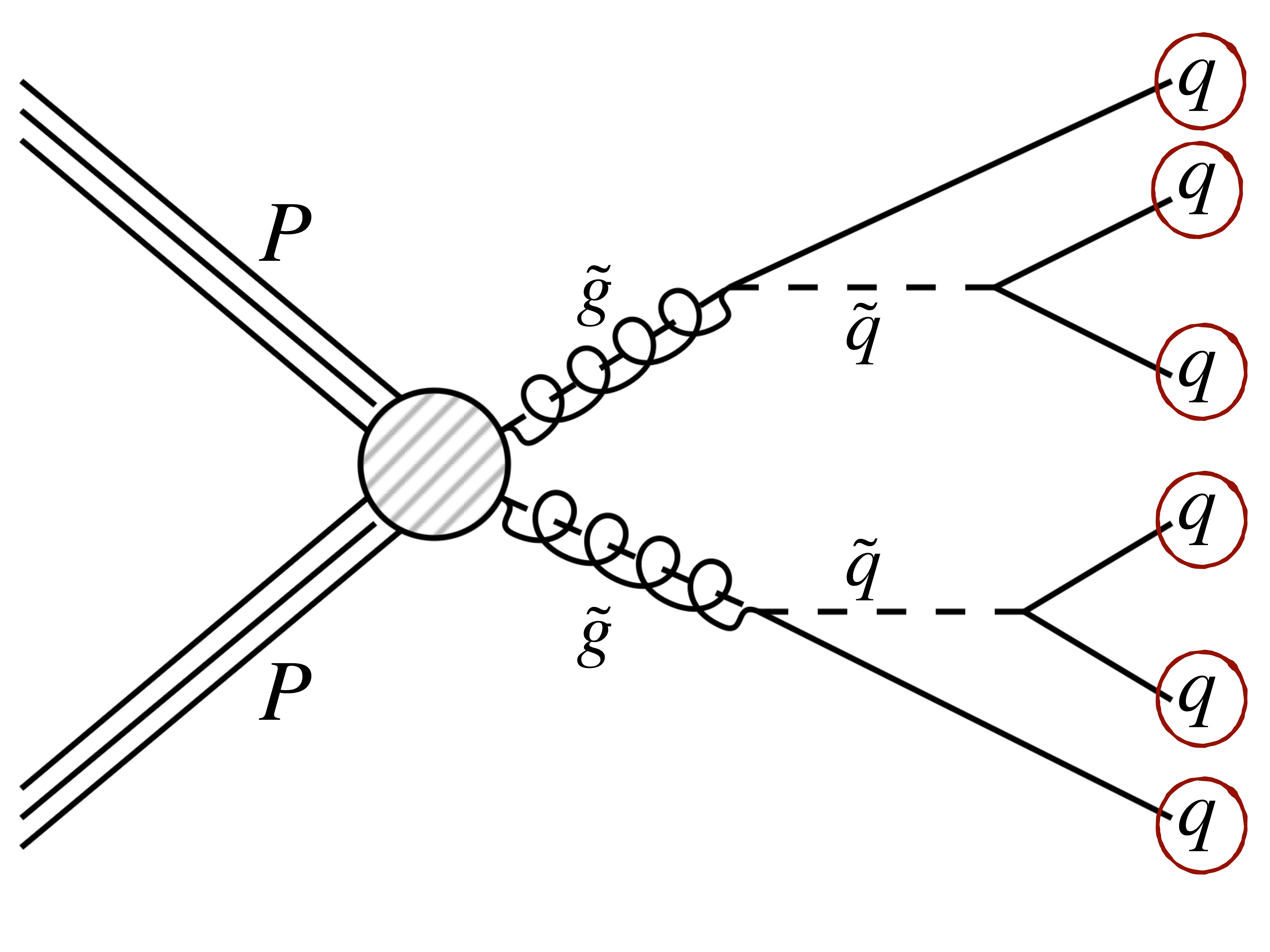
png pdf |
Figure 1-a:
Benchmark models from RPV SUSY for resolved trijets (left), merged trijets (middle) and merged dijets (right). The red circles group the final state quarks according to the expected jet clustering of their hadronization products. |
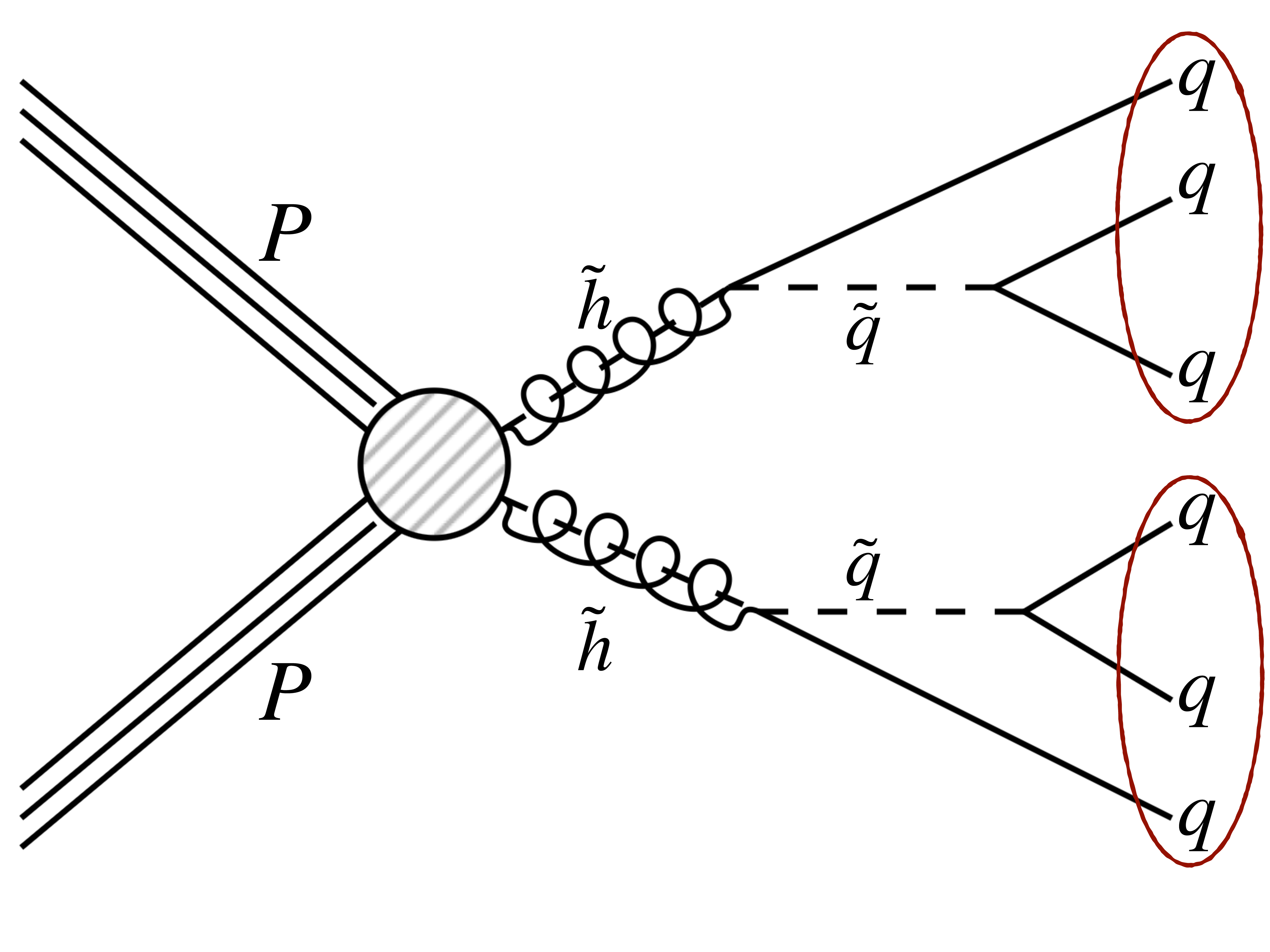
png pdf |
Figure 1-b:
Benchmark models from RPV SUSY for resolved trijets (left), merged trijets (middle) and merged dijets (right). The red circles group the final state quarks according to the expected jet clustering of their hadronization products. |
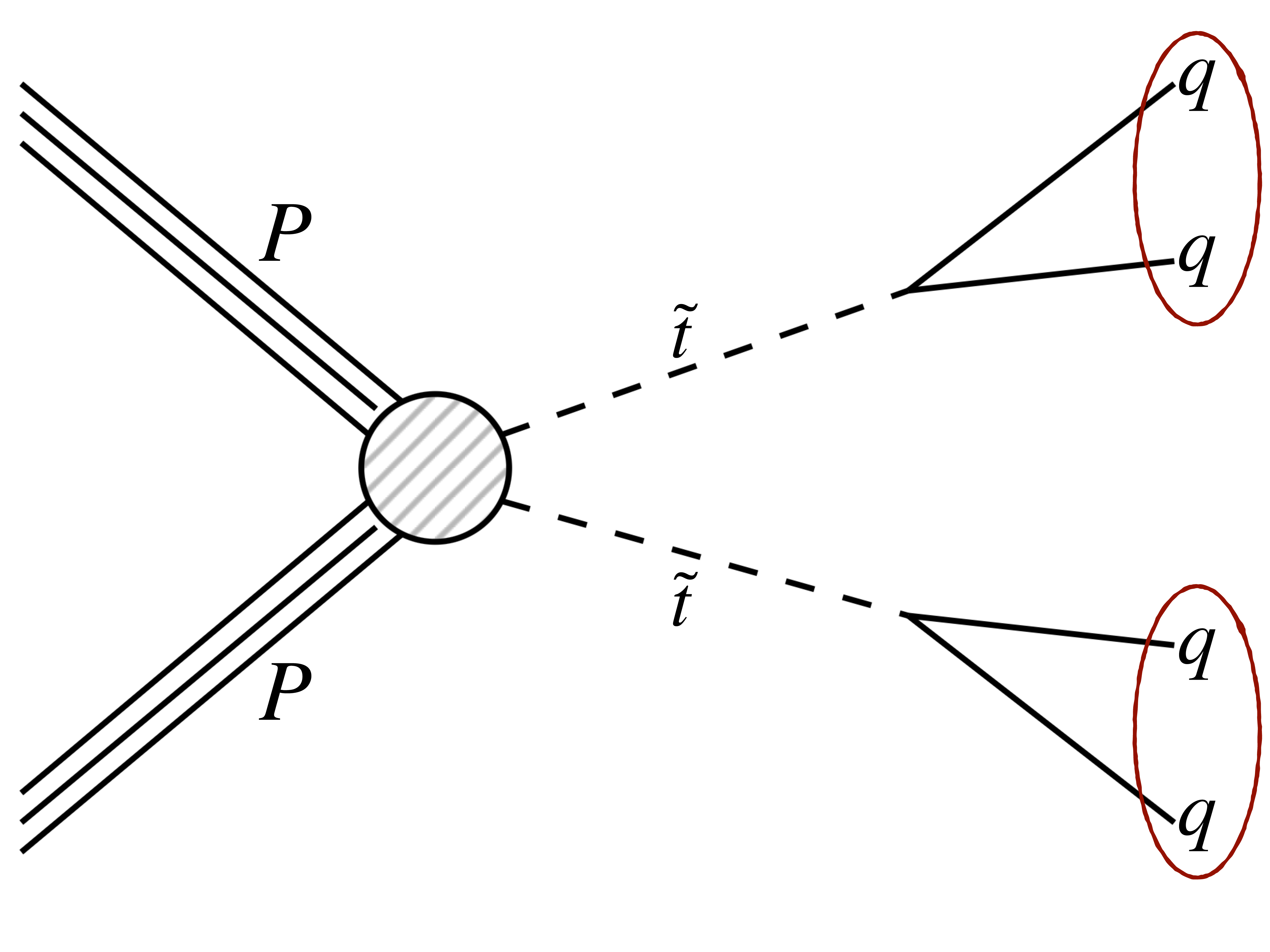
png pdf |
Figure 1-c:
Benchmark models from RPV SUSY for resolved trijets (left), merged trijets (middle) and merged dijets (right). The red circles group the final state quarks according to the expected jet clustering of their hadronization products. |
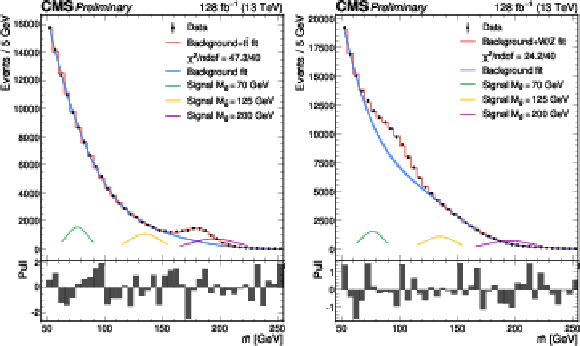
png pdf |
Figure 2:
The distribution of average jet mass in the data (points), for the search for pair-produced boosted resonances decaying to trijets (left) and dijets (right), compared to a background-only prediction from GP regression (blue), and the full background fit including simulations (red) of SM resonances from t¯t (left) and W/Z+jets (right). Also shown are the expected shapes of signals from R-parity violating gluinos with resonance masses 70 (green), 125 (yellow) and 200 GeV (purple). |
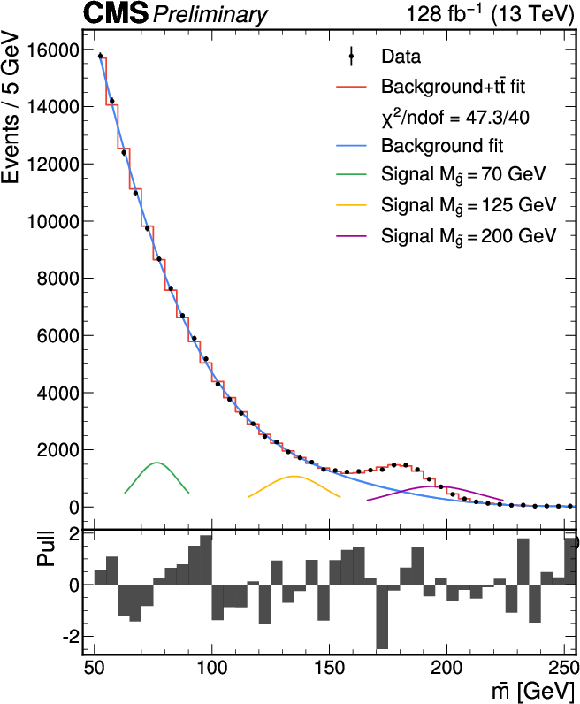
png pdf |
Figure 2-a:
The distribution of average jet mass in the data (points), for the search for pair-produced boosted resonances decaying to trijets (left) and dijets (right), compared to a background-only prediction from GP regression (blue), and the full background fit including simulations (red) of SM resonances from t¯t (left) and W/Z+jets (right). Also shown are the expected shapes of signals from R-parity violating gluinos with resonance masses 70 (green), 125 (yellow) and 200 GeV (purple). |
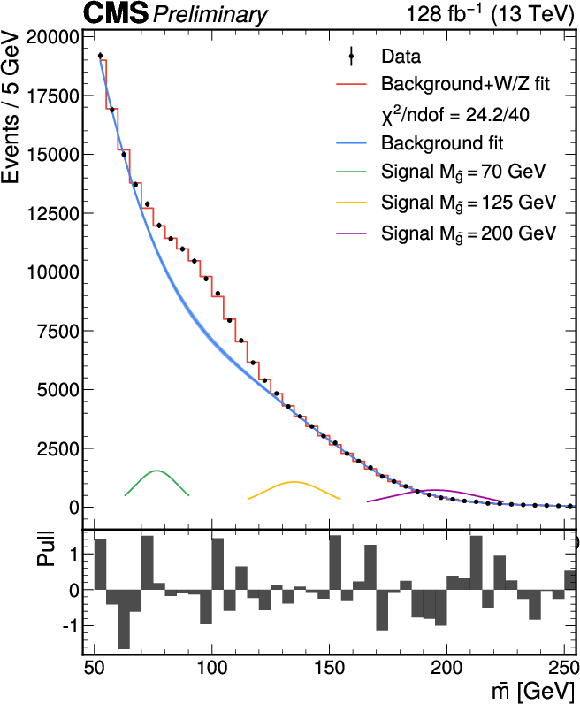
png pdf |
Figure 2-b:
The distribution of average jet mass in the data (points), for the search for pair-produced boosted resonances decaying to trijets (left) and dijets (right), compared to a background-only prediction from GP regression (blue), and the full background fit including simulations (red) of SM resonances from t¯t (left) and W/Z+jets (right). Also shown are the expected shapes of signals from R-parity violating gluinos with resonance masses 70 (green), 125 (yellow) and 200 GeV (purple). |
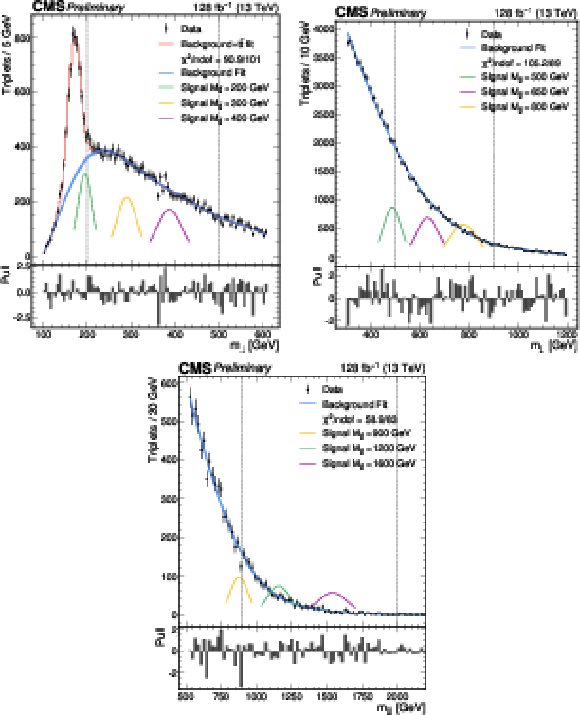
png pdf |
Figure 3:
The distribution of trijet mass in the data (points), for the three search regions (left, middle and right) for pair-produced resolved resonances decaying to trijets, compared to a background-only fit from GP regression (blue), and (left) the full background fit including simulation of a SM resonance from t tbar production (red). Also shown are the expected shapes of signals from R-parity violating gluinos at various masses (green, yellow and purple). |
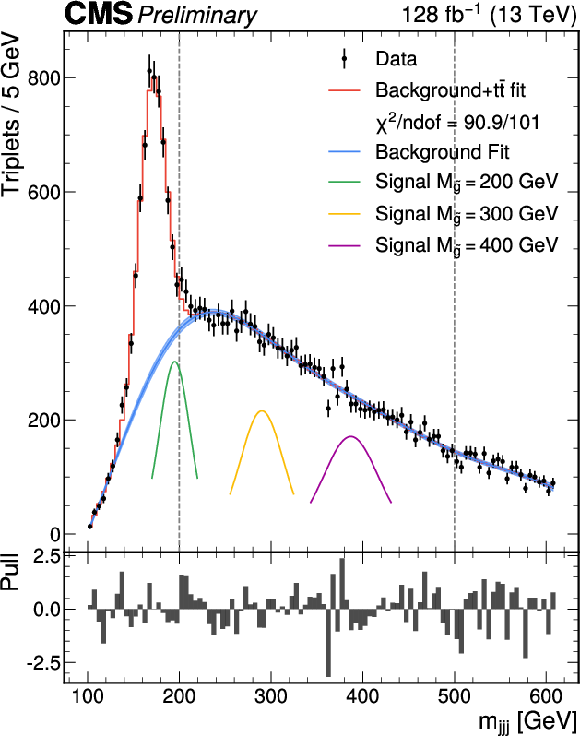
png pdf |
Figure 3-a:
The distribution of trijet mass in the data (points), for the three search regions (left, middle and right) for pair-produced resolved resonances decaying to trijets, compared to a background-only fit from GP regression (blue), and (left) the full background fit including simulation of a SM resonance from t tbar production (red). Also shown are the expected shapes of signals from R-parity violating gluinos at various masses (green, yellow and purple). |
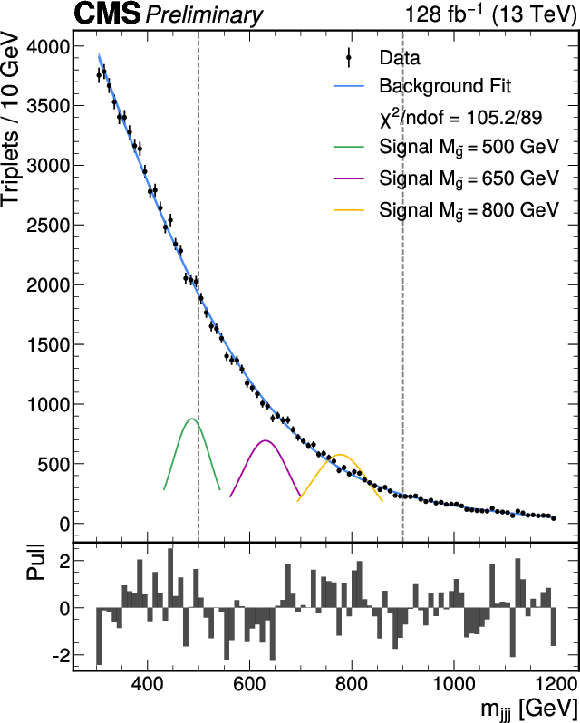
png pdf |
Figure 3-b:
The distribution of trijet mass in the data (points), for the three search regions (left, middle and right) for pair-produced resolved resonances decaying to trijets, compared to a background-only fit from GP regression (blue), and (left) the full background fit including simulation of a SM resonance from t tbar production (red). Also shown are the expected shapes of signals from R-parity violating gluinos at various masses (green, yellow and purple). |
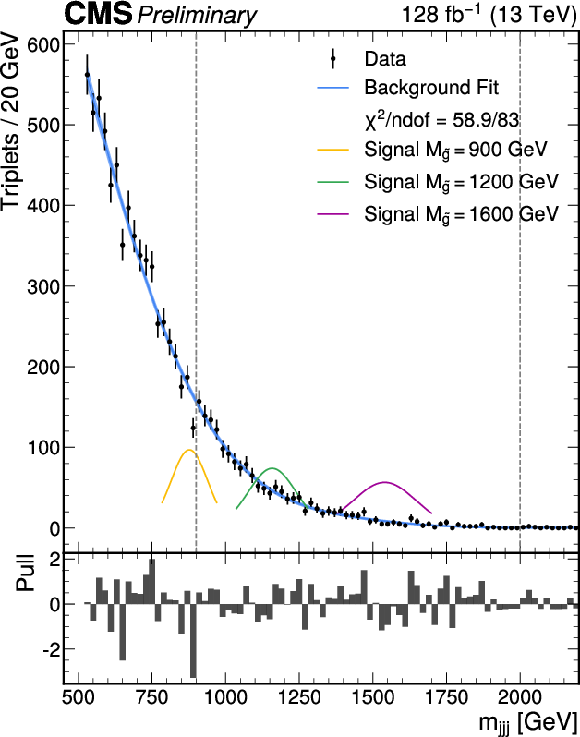
png pdf |
Figure 3-c:
The distribution of trijet mass in the data (points), for the three search regions (left, middle and right) for pair-produced resolved resonances decaying to trijets, compared to a background-only fit from GP regression (blue), and (left) the full background fit including simulation of a SM resonance from t tbar production (red). Also shown are the expected shapes of signals from R-parity violating gluinos at various masses (green, yellow and purple). |

png pdf |
Figure 4:
Observed limits (points) and expected limits (dashes) on the product of cross section (σ), branching fraction (B), and acceptance (A) for pair produced merged three quark resonances (left), pair produced merged two quark resonances (middle), and pair produced resolved three quark resonances (right). The vertical lines on the resolved three quark resonance limits (right) indicate the different search mass regions. The variations at the one and two standard deviation levels in the expected limits (shaded bands) are also shown. Limits are compared to predictions for three signals of pair production of R-parity violating resonances: gluinos (red in left and right), mass degenerate higgsinos (blue in left), and top squarks (red in middle). |

png pdf |
Figure 4-a:
Observed limits (points) and expected limits (dashes) on the product of cross section (σ), branching fraction (B), and acceptance (A) for pair produced merged three quark resonances (left), pair produced merged two quark resonances (middle), and pair produced resolved three quark resonances (right). The vertical lines on the resolved three quark resonance limits (right) indicate the different search mass regions. The variations at the one and two standard deviation levels in the expected limits (shaded bands) are also shown. Limits are compared to predictions for three signals of pair production of R-parity violating resonances: gluinos (red in left and right), mass degenerate higgsinos (blue in left), and top squarks (red in middle). |
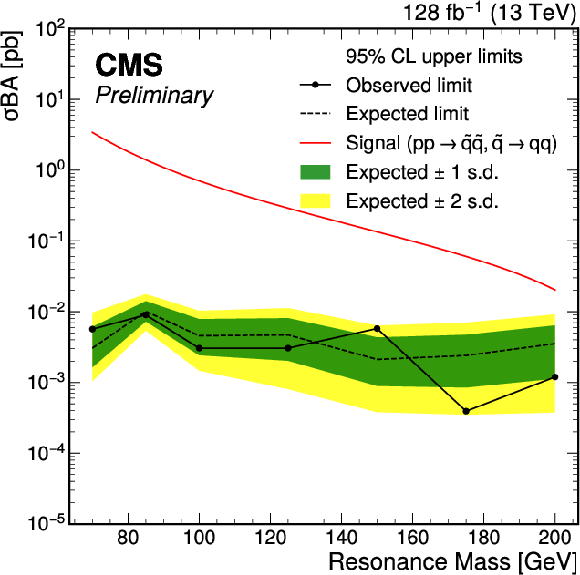
png pdf |
Figure 4-b:
Observed limits (points) and expected limits (dashes) on the product of cross section (σ), branching fraction (B), and acceptance (A) for pair produced merged three quark resonances (left), pair produced merged two quark resonances (middle), and pair produced resolved three quark resonances (right). The vertical lines on the resolved three quark resonance limits (right) indicate the different search mass regions. The variations at the one and two standard deviation levels in the expected limits (shaded bands) are also shown. Limits are compared to predictions for three signals of pair production of R-parity violating resonances: gluinos (red in left and right), mass degenerate higgsinos (blue in left), and top squarks (red in middle). |
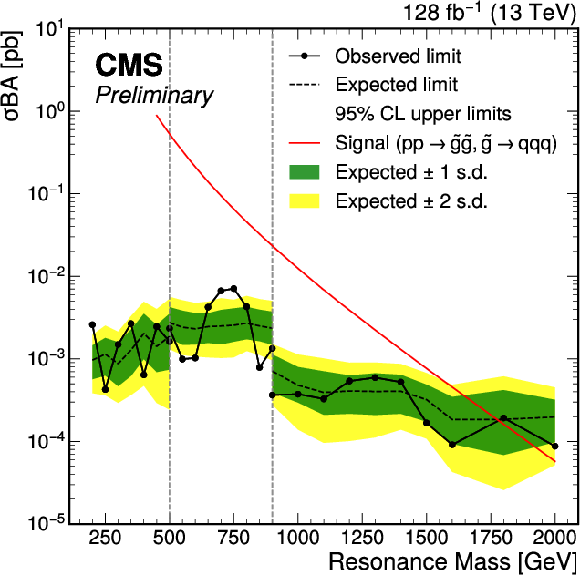
png pdf |
Figure 4-c:
Observed limits (points) and expected limits (dashes) on the product of cross section (σ), branching fraction (B), and acceptance (A) for pair produced merged three quark resonances (left), pair produced merged two quark resonances (middle), and pair produced resolved three quark resonances (right). The vertical lines on the resolved three quark resonance limits (right) indicate the different search mass regions. The variations at the one and two standard deviation levels in the expected limits (shaded bands) are also shown. Limits are compared to predictions for three signals of pair production of R-parity violating resonances: gluinos (red in left and right), mass degenerate higgsinos (blue in left), and top squarks (red in middle). |
| Tables | |

png pdf |
Table 1:
Selection requirements for the resolved trijet resonance search are listed for the three regions of gluino mass. |

png pdf |
Table 2:
Summary of the systematic uncertainties in the signal yield and shape for the searches for resolved and merged, three and two quark resonances.\\ |
| Summary |
| A search has been performed for pair-produced multijet resonances, where the jets in the final state can be either merged or individually resolved. This search observes the hadronic decays of standard model resonances, such as the top quark and W, Z bosons. New, additional resonances were not observed, with the largest effect seen for a resonance mass of 768 GeV, but with a local significance below 3 standard deviations. This search extends the previous limits on R-parity violating models of top squarks and gluinos, and sets the first limits on R-parity violating mass-degenerate, prompt, and hadronically decaying higgsinos. |
| References | ||||
| 1 | CMS Collaboration | Observation of a new boson at a mass of 125 GeV with the CMS experiment at the LHC | PLB 716 (2012) 30 | CMS-HIG-12-028 1207.7235 |
| 2 | CMS Collaboration | Observation of a new boson with mass near 125 GeV in pp collisions at √s= 7 and 8 TeV | JHEP 06 (2013) 081 | CMS-HIG-12-036 1303.4571 |
| 3 | ATLAS Collaboration | Observation of a new particle in the search for the Standard Model Higgs boson with the ATLAS detector at the LHC | PLB 716 (2012) 1 | 1207.7214 |
| 4 | Y. Fukuda et al. | Evidence for oscillation of atmospheric neutrinos | PRL 81 (1998) 1562 | |
| 5 | Muon g−2 Collaboration | Measurement of the positive muon anomalous magnetic moment to 0.46 ppm | PRL 126 (2021) 141801 | |
| 6 | LHCb Collaboration | Test of lepton universality in beauty-quark decays | NP 18 (2022) 277 | 2103.11769 |
| 7 | R. Barbier et al. | R-parity violating supersymmetry | Phys. Rept. 420 (2005) 1 | hep-ph/0406039 |
| 8 | P. Asadi | New solutions to the charged current B-anomalies | PhD thesis, Rutgers U., Piscataway, 2019 link |
|
| 9 | H. Easa, T. Gregoire, and D. Stolarski | New limits on coloured three jet resonances | JHEP 09 (2020) 131 | 2003.00014 |
| 10 | B. A. Dobrescu, R. M. Harris, and J. Isaacson | Ultraheavy resonances at the LHC: beyond the QCD background | Technical Report, FERMILAB-PUB-18-561-T, 2018 | 1810.09429 |
| 11 | CMS Collaboration | Search for resonant and nonresonant production of pairs of dijet resonances in proton-proton collisions at √s= 13 TeV | JHEP 07 (2023) 161 | CMS-EXO-21-010 2206.09997 |
| 12 | S. Mukherjee | Data scouting: A new trigger paradigm | CMS Collaboration, in 5th Large Hadron Collider Physics Conference. 8, 2017 | 1708.06925 |
| 13 | CDF Collaboration | First search for multijet resonances in √s= 1.96 TeV pˉp collisions | PRL 107 (2011) 042001 | 1105.2815 |
| 14 | ATLAS Collaboration | Search for massive supersymmetric particles decaying to many jets using the ATLAS detector in pp collisions at √s= 8 TeV | PRD 91 (2015) 112016 | 1502.05686 |
| 15 | ATLAS Collaboration | Search for R-parity-violating supersymmetric particles in multi-jet final states produced in pp collisions at √s= 13 TeV using the ATLAS detector at the LHC | PLB 785 (2018) 136 | 1804.03568 |
| 16 | CMS Collaboration | Search for three-jet resonances in pp collisions at √s= 7 TeV | PLB 718 (2012) 329 | CMS-EXO-11-060 1208.2931 |
| 17 | CMS Collaboration | Searches for light- and heavy-flavour three-jet resonances in pp collisions at √s= 8 TeV | PLB 730 (2014) 193 | CMS-EXO-12-049 1311.1799 |
| 18 | CMS Collaboration | Search for pair-produced three-jet resonances in proton-proton collisions at √s=13 TeV | PRD 99 (2019) 012010 | CMS-EXO-17-030 1810.10092 |
| 19 | ATLAS Collaboration | A search for top squarks with R-parity-violating decays to all-hadronic final states with the ATLAS detector in √s= 8 TeV proton-proton collisions | JHEP 06 (2016) 067 | 1601.07453 |
| 20 | ATLAS Collaboration | A search for pair-produced resonances in four-jet final states at √s= 13 TeV with the ATLAS detector | EPJC 78 (2018) 250 | 1710.07171 |
| 21 | ATLAS Collaboration | Search for pair production of massive particles decaying into three quarks with the ATLAS detector in √s= 7 TeV pp collisions at the LHC | JHEP 12 (2012) 086 | 1210.4813 |
| 22 | CMS Collaboration | Search for pair-produced resonances decaying to jet pairs in proton-proton collisions at √s= 8 TeV | PLB 747 (2015) 98 | CMS-EXO-12-052 1412.7706 |
| 23 | CMS Collaboration | Search for pair-produced resonances decaying to quark pairs in proton-proton collisions at √s= 13 TeV | PRD 98 (2018) 112014 | CMS-EXO-17-021 1808.03124 |
| 24 | CMS Collaboration | The CMS experiment at the CERN LHC | JINST 3 (2008) S08004 | |
| 25 | CMS Collaboration | Performance of the CMS level-1 trigger in proton-proton collisions at √s= 13 TeV | JINST 15 (2020) P10017 | CMS-TRG-17-001 2006.10165 |
| 26 | CMS Collaboration | The CMS trigger system | JINST 12 (2017) P01020 | CMS-TRG-12-001 1609.02366 |
| 27 | CMS Collaboration | Electron and photon reconstruction and identification with the CMS experiment at the CERN LHC | JINST 16 (2021) P05014 | CMS-EGM-17-001 2012.06888 |
| 28 | CMS Collaboration | Performance of the CMS muon detector and muon reconstruction with proton-proton collisions at √s= 13 TeV | JINST 13 (2018) P06015 | CMS-MUO-16-001 1804.04528 |
| 29 | CMS Collaboration | Description and performance of track and primary-vertex reconstruction with the CMS tracker | JINST 9 (2014) P10009 | CMS-TRK-11-001 1405.6569 |
| 30 | CMS Collaboration | Particle-flow reconstruction and global event description with the CMS detector | JINST 12 (2017) P10003 | CMS-PRF-14-001 1706.04965 |
| 31 | CMS Collaboration | Performance of reconstruction and identification of τ leptons decaying to hadrons and ντ in pp collisions at √s= 13 TeV | JINST 13 (2018) P10005 | CMS-TAU-16-003 1809.02816 |
| 32 | CMS Collaboration | Jet energy scale and resolution in the CMS experiment in pp collisions at 8 TeV | JINST 12 (2017) P02014 | CMS-JME-13-004 1607.03663 |
| 33 | CMS Collaboration | Performance of missing transverse momentum reconstruction in proton-proton collisions at √s= 13 TeV using the CMS detector | JINST 14 (2019) P07004 | CMS-JME-17-001 1903.06078 |
| 34 | CMS Collaboration | Particle-flow reconstruction and global event description with the CMS detector | JINST 12 (2017) P10003 | CMS-PRF-14-001 1706.04965 |
| 35 | J. Alwall et al. | MadGraph/MadEvent v4: The new web generation | JHEP 09 (2007) 028 | 0706.2334 |
| 36 | T. Sjöstrand et al. | An introduction to PYTHIA 8.2 | Comput. Phys. Commun. 191 (2015) 159 | 1410.3012 |
| 37 | S. Mrenna and P. Richardson | Matching matrix elements and parton showers with HERWIG and PYTHIA | JHEP 05 (2004) 040 | hep-ph/0312274 |
| 38 | M. Cacciari, G. P. Salam, and G. Soyez | FastJet user manual | EPJC 72 (2012) 1896 | 1111.6097 |
| 39 | M. Cacciari and G. P. Salam | Dispelling the N3 myth for the kT jet-finder | PLB 641 (2006) 57 | hep-ph/0512210 |
| 40 | M. Cacciari, G. P. Salam, and G. Soyez | The anti-kt jet clustering algorithm | JHEP 2008 (2008) 063 | |
| 41 | CMS Collaboration | Pileup mitigation at CMS in 13 TeV data | JINST 15 (2020) P09018 | CMS-JME-18-001 2003.00503 |
| 42 | CMS Collaboration | Jet performance in pp collisions at 7 TeV | CMS Physics Analysis Summary, 2010 link |
|
| 43 | D. Krohn, J. Thaler, and L.-T. Wang | Jet trimming | JHEP 02 (2010) 084 | 0912.1342 |
| 44 | J. Thaler and K. Van Tilburg | Identifying boosted objects with N-subjettiness | JHEP 03 (2011) 015 | 1011.2268 |
| 45 | I. Moult, L. Necib, and J. Thaler | New angles on energy correlation functions | JHEP 12 (2016) 153 | 1609.07483 |
| 46 | J. Dolen et al. | Thinking outside the ROCs: Designing decorrelated taggers (DDT) for jet substructure | JHEP 05 (2016) 156 | 1603.00027 |
| 47 | P. T. Komiske, E. M. Metodiev, and J. Thaler | Energy flow networks: Deep sets for particle jets | JHEP 01 (2019) 121 | 1810.05165 |
| 48 | C. E. Rasmussen and C. K. I. Williams | Gaussian processes for machine learning | The MIT Press, . , ISBN~9780262256834, 2005 link |
|
| 49 | A. Gandrakota, A. Lath, A. V. Morozov, and S. Murthy | Model selection and signal extraction using Gaussian process regression | JHEP 02 (2023) 230 | 2202.05856 |
| 50 | M. Frate et al. | Modeling smooth backgrounds and generic localized signals with Gaussian processes | 1709.05681 | |
| 51 | D. Foreman-Mackey, D. W. Hogg, D. Lang, and J. Goodman | emcee: The MCMC hammer | Publ. Astron. Soc. Pac. 125 (2013) 306 | |
| 52 | G. Cowan, K. Cranmer, E. Gross, and O. Vitells | Asymptotic formulae for likelihood-based tests of new physics | EPJC 71 (2011) 1554 | 1007.1727 |
| 53 | C. Borschensky et al. | Squark and gluino production cross sections in pp collisions at √s= 13, 14, 33 and 100 TeV | EPJC 74 (2014) 3174 | 1407.5066 |

|
Compact Muon Solenoid LHC, CERN |

|

|

|

|

|

|